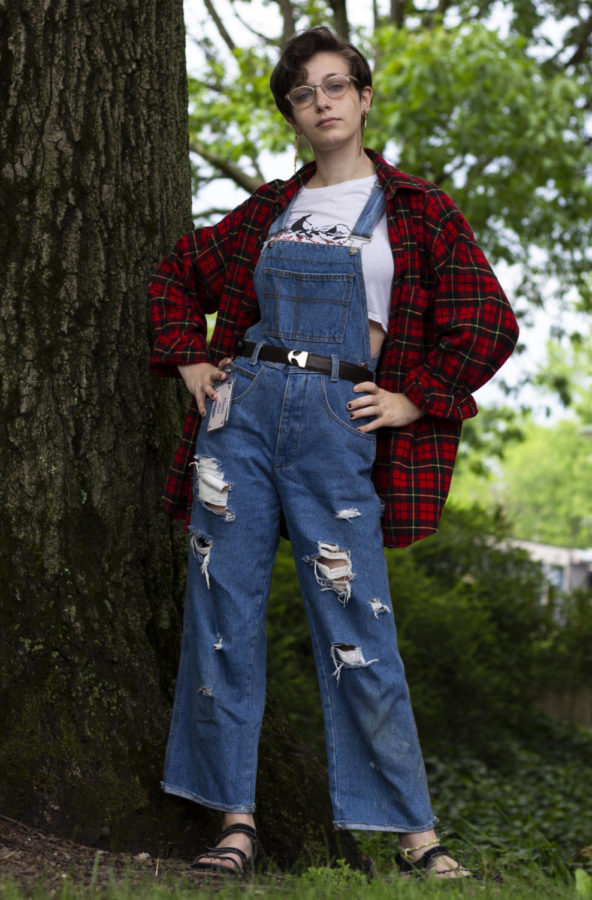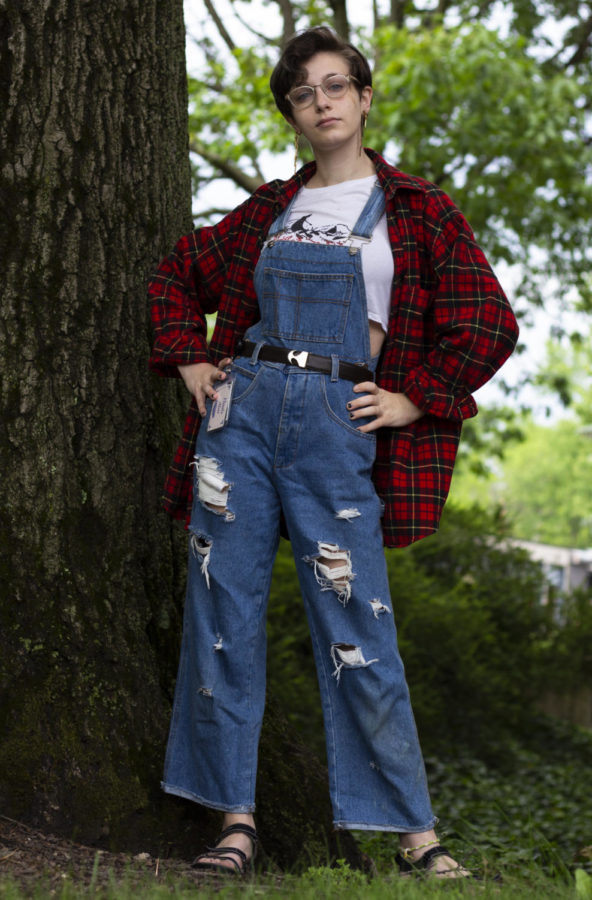
If you’re walking down the hallway of King Building, you’ll likely become enveloped in a clashing cacophony of vibrant prints and crunchy Carhartt neutrals. Oberlin’s fashion scene has long been a strong factor of student life; experimenting with outfits is embraced as a medium of self-expression. For some Obies, building an outfit is just for fun, while others use their clothing to express deeply important identities of race, class, gender presentation, sexual orientation, and more.
“[For] the ‘traditional’ Obies, I see a lot more statement pieces, like the really cool pattern pants, or really cool shirts, kind of like the mixing and matching patterns,” College second-year Iyanna Lewis said. “I also see an equal amount of sweat pants.”
Oberlin style often transcends clothing choice — for many Obies, outfits are a full-body process.
“Oberlin fashion is very unique,” said Brendan Aleman, OC ’21, “People usually put a lot of time into their ’fits is what I realized. You have matching the eye shadow with the shoes, with the sneakers, with the socks and crazy stuff like that. Very in-your-face, bold, ‘This is who I am.’”
For other students, how they dress is deeply impacted by which micro-communities they interact with at Oberlin. College second-year Iyanna Lewis, who is on both the volleyball and track and field team, appreciates the marriage of sportswear and fashion when she works out.
“I feel like weight room fashion is kind of a vibe,” she said. “I’d be like, oh, your leggings look really cute. Like, ‘Oh, where’d you get that? Like, where’d you get that shirt?’”
Being a student athlete is not the only thing that Lewis sees impacting her style on campus.
“In terms of the Black community, we have some very interesting fashion,” Lewis said. “I think a lot of us really tap into street wear, … but there’s also a lot of variety.”
Within this variety, one encounters the trendy-niche, with some Oberlin students intermingling era and region to emulate very specific looks. College second-year Theo Canter named a couple he had noticed.
“There’s like a group of people who kind of all dress like ’90s LA, off-SKA, skater-ish,” he said. “There are some who [dress] Brooklyn techno-gothy.”
Canter also mentioned that students are still welcomed if fashion isn’t an interest of theirs.
“I heard someone say when I first got here, like, it’s nice to not have to worry anymore about what they wear, like how it looks,” Canter said. “Since I heard that, I’ve really identified with that. I think I worry less if my shirt and pants match.”
The enormous range of style is largely a product of one of Oberlin’s most popular trends: thrifting and reusing. Angelo Passaro, OC ’21, said that for him, the practice of sustainable clothing consumption not only defined Oberlin’s style, but also his own.
“I think it’s different for everybody, but I think that something that really unites Oberlin fashion is recycling other people’s clothing,” he said. “The concept of the free box is very integral to Oberlin fashion to me. And having a community of people, like in my co-ops who would compliment me or ask me like, do you want to go to Volunteers [of America] together? … was really encouraging for me to experiment and show off different things.”
Along with thrifting’s popularity at Oberlin, its prevalence comes with a larger ethical dialogue about socioeconomic class and equity.
“I feel like you could say that a lot of thrift stores are theoretically intended for low-income people to be able to afford those kinds of clothes,” Canter said. “I mean, that’s a whole debate … I think most of the kids who I know who are always like, oh, I got it at Volunteers, they have enough money to have a fancy car to drive themselves to Volunteers … which I don’t think is an outright sin. The stores are there, and there’s plenty of clothes. But I guess there’s the deeper question: How can we achieve solidarity while acknowledging our differences?”
As a first-generation and low-income student, Aleman said that the difference between his friends’ thrifted appearance and thrifting out of necessity led to some uncomfortable situations.
“Having money, but then playing down that you have money to someone who’s low-income can be troublesome in the sense of helping them navigate white spaces and giving them agency,” Aleman said. “Because for example, there’s been plenty of times where I’ve gone out with people who I initially thought were from similar backgrounds as me, and so we at first bonded over that. And then they asked me to go out every other weekend to like the Feve or go on fancy trips on spring break. And I’m just like I don’t have money to do that. And then they’ll be like, ‘Oh no, but I’ll pay for you.’ It just makes me feel a little weird having other people pay for me, because this is a reminder for low-income students, like this space isn’t necessarily meant for you.”
The enthusiasm for thrifting and experimentation can also lead to cultural appropriation in fashion — something that Lewis has noticed happening occasionally around campus.
“Streetwear is very popular right now and not acknowledging that that came from Black people, and understanding that, even though trends are recycling, not paying attention to where they came from can be very detrimental because if you do it incorrectly or you try to claim it as your own, it can be seen as very offensive,” said Lewis. “We can’t police it, which is really hard, because if something were to be truly harmful, I personally don’t know how to address it. ’Cause I could just go up and be like, ‘Hey, what you’re wearing is not cool at all,’ but also sometimes, I’m not that confrontational of a person.”
Adding gender and sexuality onto questions of culture and class status makes these conversations even more complex. As someone who has recently transitioned, Passaro is actively grappling with how to dress in a way that clearly expresses his gender identity to other Obies.
“Unless people understand your gender presentation, it’s really hard for people to understand correctly the way that you are trying to present something,” Passaro said. “It’s a tough problem because as much as fashion is about expressing yourself, you’re always thinking about an audience … and that’s not really in your control most of the time.”
For some students, the conversations that Oberlin students have about fashion can feel a bit like gatekeeping. Aleman encountered a moment when, in a gender studies course, someone told him that the flannel he was wearing was only appropriate for for gay women to wear.
“Having communities police what certain communities can wear, being like, ‘LGBTQ+ communities can only wear this,’ or, ‘You can’t wear this if you’re cis[gender]’ — It’s a little problematic, but I understand it,” he said. “I think sometimes when you lack representation you kind of want to hold onto the one identifier that you have.”
Obies love to make art from the quotidian, and fashion offers a means of merging artistic flair with self expression. But many Obies say outfits should be treated with the intentionality of art, and the boundaries of cultural appropriation and class obfuscation should frame our outfit curation. Lewis suggests we take a moment to step back and take the time to really think about our ‘fits, and what they could be communicating.
She says, “I think it has to be on more of an individual basis of making sure, like: ‘Hey, is there any possibility of what I’m wearing, being offensive?’”

